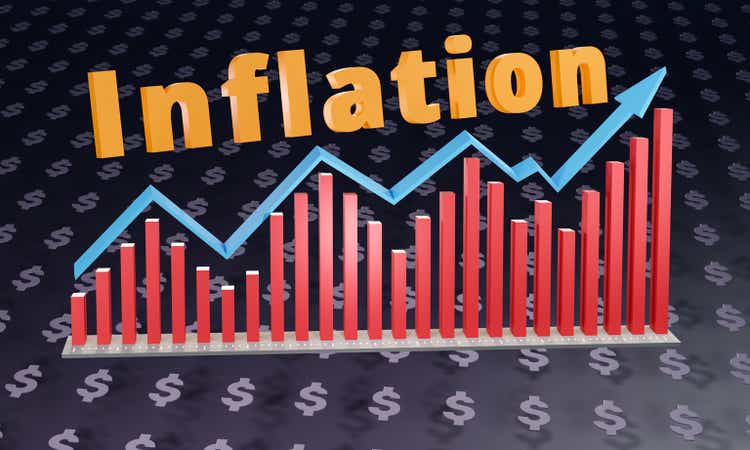Torsten Asmus/iStock via Getty Images
Last Tuesday, the Labor Department announced that its Consumer Price Index (CPI) surged 1.2% in March to an 8.5% annual pace (year over year). Gasoline prices surged 18.3% in March and accounted for approximately half of the CPI increase. The core CPI, excluding food and energy, rose 0.3%, rising 6.5% in the past 12 months. Shockingly, fuel oil surged 22.3% in March and 70.1% in the past year!
Other notable price surges were airline fares, up 10.7% in March and almost 24% in the past 12 months. Used car prices were up 35.3% in the past 12 months but down 3.8% in March. Also, electricity prices rose 2.2% in March and 11.1% in the past 12 months, due mostly to higher coal and natural gas prices.
Food prices were up but not as dramatically as fuel, rising 1% in March and 8.8% in the past 12 months. Overall, the March CPI delivered the largest monthly surge since 2005 and the largest 12-month gain since 1982. The core CPI is also running at the fastest annual pace in four decades (since August 1982).
The next day, Wednesday, the Labor Department announced that its Producer Price Index (PPI) surged 1.4% in March and a shocking 11.2% in the past 12 months, the largest gain since that series began in 2010. This was a big surprise, since economists were only expecting March to rise 1.1%. Wholesale food prices rose 2.4%, while wholesale energy prices surged 5.7%. Excluding food, energy, and trade margins, the core PPI rose 0.9% in March and 7% in the past 12 months. Economists were only expecting the core PPI to rise 0.5%, so 0.9% was a big shock. After seeing all these numbers, I think it is obvious that the Fed will have to raise rates 0.5% at its upcoming Federal Open Market Committee (FOMC) meeting.
Meanwhile, the Fed’s most famous “bomb thrower” in the 12 Fed districts, namely St. Louis Fed President James Bullard, in an interview with the Financial Times last week, said it is a “fantasy” to believe that the Fed can bring down inflation sufficiently without raising key interest rates to a level where they will constrain economic growth. Specifically, Bullard said that the Fed funds rate should move up “sharply” after the May FOMC meeting. He even endorsed a rate of 3% by the third quarter (starting from near zero in January). Bullard pointed to former Fed Chair Paul Volcker’s decision to raise the Fed funds rate to 20% in 1980 “because the committee (FOMC) didn’t have enough credibility.”
Oddly enough, when Fed Chairman Paul Volcker killed inflation by pushing rates to 20% and causing two back-to-back recessions (from 1979 to 1982), I was working for the Federal Home Loan Bank (the Savings & Loan regulator). I watched in 1980 as Volcker allowed the Federal Funds rate to soar to 20% on March 18th, only to plunge it back to 8.5% on June 5th and then raising it to 20% on December 5th.
Naturally, these wide swings in the basic Fed funds rate were very disruptive to businesses, especially the homebuilding industry. In fact, I remember that a Michigan homebuilder spoke before Congress and got very emotional, demanding that Paul Volcker’s head be “put on a platter,” since these wild interest rate swings were destroying his homebuilding business! It certainly did disrupt the housing market in 1980!
Let’s hope and pray that the Fed never goes to such extremes again, like Chairman Volcker did in 1980. The good news is that such moves will likely not be necessary, since we may have seen “peak inflation” in the March report. Inflation rates should recede in April (in the report to be released in mid-May), as crude oil prices briefly hit a six-week low early last week due to fears of slumping global demand due to China’s Covid-19 shutdown as well as a recession enveloping Europe. There are also frustrated voters in many countries, such as France, where President Emmanuel Macron will have a runoff election with nationalist Marine Le Pen. More countries will voice their monetary concerns if fuel prices don’t retreat.
Last Week’s Economic Indicators – Mixed but Hopeful
Besides the major inflation indicators, the other economic indicators last week were mixed but hopeful. No matter how downbeat some of the news may seem, it’s usually better in the U.S. than anywhere else.
On Thursday, the Labor Department announced that jobless claims in the latest week rose to 185,000, up from a revised 167,000 in the previous week. Continuing unemployment claims came in at 1.475 million in the latest week, down from 1.523 million in the previous week. This latest rise in weekly jobless claims is likely just “statistical noise,” since unemployment claims remain near a 54-year low. Furthermore, the fact that continuing jobless claims keep declining is very positive and a sign of a healthy labor market.
Also on Thursday, the Commerce Department announced that retail sales rose 0.5% in March and February’s retail sales were revised up to a 0.8% increase (from the 0.3% previously reported). Part of that gain was inflationary, since sales at gasoline stations rose 8.9% in March, due mostly to higher prices at the pump. Excluding gasoline station sales, however, overall retail sales still rose 0.3% in March.
There were a lot of encouraging details in the March retail sales report, such as: general merchandise store sales rose 5.4%, clothing store sales rose 2.6%, online sales rose 6.4%, and sales at restaurants and bars rose 1% – signs that we are emerging from our COVID shells. Overall, stagflation persists, since the inflation is outpacing retail sales growth, but I was encouraged by some of the details in the March report.
Turning to the GDP, the Atlanta Fed on Thursday reaffirmed that its first-quarter GDP estimate remains at a positive (+1.1%) annual pace, so the Fed is still expecting a “soft landing” for overall economic growth.
This week’s initial quarterly earnings announcements by major financial institutions are expected to shed further light on whether or not an inverted yield curve is squeezing financial stocks’ operating margins.
Treasury yields continue to rise. Early last week, the 10-year Treasury bond yield rose above 2.75% to its highest level in three years. Fortunately, after Tuesday’s CPI report, Treasury bond yields contacted a bit.
Despite some profit-taking in technology stocks as Treasury yields rose, it is important to remember that interest rates have very little, if anything, to do with technology stocks. Wall Street loves to try to shake investors out of growth stocks before their quarterly earnings announcements, but I feel it is important to wait for the biggest wave of announcements – starting next week – since they often lift our growth stocks.
Closing Comments on Elon Musk, the Media, and a Possible Twitter Takeover
In conclusion, I find it very interesting that the mainstream media seem to find it chilling that Elon Musk wants to control Twitter (TWTR) – to open it up to more viewpoints – while the same media applauded Jeff Bezos for taking over The Washington Post, even though he seemed to use that paper as a political pulpit.
@BusinessInsider
Elon Musk and Jeff Bezos are the two richest men in the world, and they are basically trying to do the same thing in media; but Silicon Valley seemingly speaks with one voice, so Musk is now their enemy. Looking at his offer strictly from a shareholder’s point of view, this is a good move for Twitter.
Navellier & Associates owns Twitter Inc. (TWTR) in some managed accounts. Louis Navellier does not personally own Twitter Inc. (TWTR).
All content above represents the opinion of Louis Navellier of Navellier & Associates, Inc.
Disclaimer: Please click here for important disclosures located in the “About” section of the Navellier & Associates profile that accompany this article.
Disclosure: *Navellier may hold securities in one or more investment strategies offered to its clients.
Editor’s Note: The summary bullets for this article were chosen by Seeking Alpha editors.


Be the first to comment